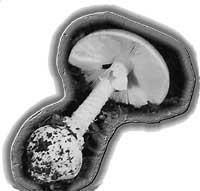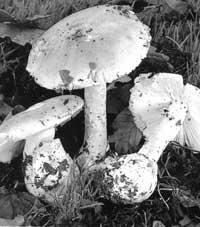Amanita phalloides: the green killer of forests
Toxins

Two types of cyclopeptides can be distinguished between the chemical compounds causing the damage: phalotoxins and amatoxins. Both are found in some species such as Amanita virosa, Galeriana or Lepiota.
To understand how poisoning occurs, it must be taken into account that these substances, because they are very thermoset, are not destroyed cooked, neither the enzymatic methods or the maintenance of dry for years eliminate the effect of these substances.
Although phalotoxin can quickly cause hemorrhagic liver injury in certain animals, human hepatocytes (i.e., major liver cells) have no receptor with the same substance, so it is not very toxic to us.
Amatoxins, on the other hand, have a late effect and are the main causes of damage in most cases. When amanitine inhibits the rna-polymerase enzyme, it also inhibits DNA transcription from RNA, preventing protein synthesis and causing cell necrosis. This compound affects all eukaryotic cells and focuses on the epithelium, kidney, pancreas, testes or blood cells of the digestive tract. It also produces a greater impact on the liver due to the high protein synthesis it maintains.
Like many other substances, they absorb into the digestive system and pass through the liver through the portal vein before amatoxins spread through the body. The liver, however, can reflush 60% through the bile into the small intestine to be expelled along with the rest of the waste. This would be beneficial if, in addition to absorbing again and completing a cycle (entero-hepatic cycle), hepatocyte did not stretch its exposure to the toxic.
The belief that mushrooms eaten by animals are not harmful has also caused more than one poisoning. The digestive system of rats and mice does not absorb amatoxin and if it is administered by vein the damage is less when entero-hepatic cycle does not occur.
Clinic

Symptoms take between 6 and 12 hours, as in most serious mushroom poisoning. The poisoning usually given by the clinic before two hours is usually mild. Initially diarrhea, abdominal pain and vomiting predominate, which can last about 24 hours, causing alterations of dehydration and electrolytes (sodium, potassium, hydrogen, etc. ). Then, after a phase of improvement, comes the attack of viscera. Although damage to the kidneys, pancreas, bone marrow and other organs is seen in the analyses, the main problem is liver damage: bleeding, hypoglycemia, coma and death by 10-30%.
Although symptoms and what the patient says are most important when making the diagnosis, amanitine can be detected in the urine. Mushroom experts (in Gipuzkoa we have the appreciable help of the Aranzadi Group mycologists) can also collaborate greatly in the development of the diagnosis.
Treatment

Since there are no substances that can neutralize these toxins, it is recommended that these patients be treated in the Intensive Care Unit. It is very important to remove amanitine from the intestine by gastric and palliative washing and break the entero-hepatic cycle.
The toxin can also be removed by urine, so the number of urine should be increased by abundant venous serums and diuretics. Several studies have clarified that if done so, the poison disappears within a shorter time from urine. Hemodialysis and plasmapheresis commonly used in other intoxications are not useful in this case. Being a molecule too large for the first does not pass the filter and for the second does not join the proteins.
Penicillin and silibiline are also used in treatment, especially the first four days. In addition to causing further kidney expulsion, it seems to somehow break the entero-hepatic cycle.
When things are wrong you can get a liver transplant. In addition to being a complex technique carried out in few hospitals, few cases have been reported. The best treatment is undoubtedly to let rats and mice taste this greenish mushroom, so hostile to our liver.
Buletina
Bidali zure helbide elektronikoa eta jaso asteroko buletina zure sarrera-ontzian











